


A plate block is a block of stamps from the edge of the sheet which shows the plate or cylinder from which the stamps were printed.



A plate block is a block of stamps from the edge of the sheet which shows the plate or cylinder from which the stamps were printed.
The numbering of printing plates has long been a part of quality control in the printing process. That way, if someone at the printing plant notices a problem with the printing of a certain stamp, the plate number can be used to locate the proper plate or cylinder so the problem can be investigated. [1]
In some cases, for instance the Penny Reds of Great Britain and modern United States plate number coils, the plate numbers appear in the stamps themselves, but the more common practice is to include the number in the margin of each sheet, sometimes alongside the name of the printer.
On coil stamps (stamps issued in a long band of single stamps with the edges imperforate) a plate number sometimes is printed on the margin of a stamp, which collectors refer to as a plate number coil. Mint plate number coil stamps are most often collected as strips of three or five with the stamp with the plate number at the center of the strip. [2]
In the U.K. plate blocks are also commonly known as cylinder blocks and are widely collected as they still form an important part of the printing process for current British stamps.
British stamps have also included a system of "controls" which were first used in February 1884 and continued until 1947. The "control" consisted of a letter in the selvedge of the sheet and was introduced as an accounting method by the printers due to the very large number of low value definitive stamps they were printing. [3]
Until the late 1960s, United States stamps included two rows of stamps attached to one another in a block of four or more, with printing information, including the printing plate number, on attached margin paper. A number is used to identify one specific plate or cylinder used to print the stamps.
Then plate block collecting changed in the US due to the addition of up to eight multi-digit numbers which represented different colors used to print the stamps. The numbers were printed along the selvage. This meant collectors needed many more stamps to save a single plate block. [4] This lasted for about ten years before the post office reverted to the traditional single number for most stamps. [4] In a press release dated Dec. 10, 1980, the postal service announced a new plate numbering system that would, except in cases where more than four designs appear on a pane, "establish a plate block as consisting of four stamps regardless of the number of inks used or the press used to print the stamps." [5] Now, new issues often begin with a number such as "11111," with each digit in a different color. [1] Stamps printed in large quantities may have multiple plate numbers so the next plate combination might be identified as "22222" and so on. [1]
The usual practice in plate block collecting varies by country and era; the classic 20th century US plate block consisted of a 2 x 3 block in the middle top, bottom and/or sides of the sheet for flat plate issues (a 2 x 2 block in the corner of the sheet for rotary press issues). Ambitious collectors will seek to own blocks displaying every known plate number for the stamp; specialized stamp catalogs will list these. They may also collect all of the block positions, such as the numbers of each corner that exist after a large sheet is quartered.
| Wikimedia Commons has media related to Plate block . |
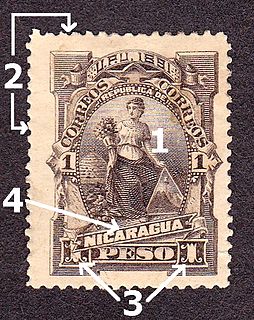
A postage stamp is a small piece of paper issued by a post office, postal administration, or other authorized vendors to customers who pay postage, who then affix the stamp to the face or address-side of any item of mail—an envelope or other postal cover —that they wish to send. The item is then processed by the postal system, where a postmark or cancellation mark—in modern usage indicating date and point of origin of mailing—is applied to the stamp and its left and right sides to prevent its reuse. The item is then delivered to its addressee.

Stamp collecting is the collecting of postage stamps and related objects. It is related to philately, which is the study of stamps. It has been one of the world's most popular hobbies since the late nineteenth century with the rapid growth of the postal service, as a never-ending stream of new stamps was produced by countries that sought to advertise their distinctiveness through their stamps.

A watermark is an identifying image or pattern in paper that appears as various shades of lightness/darkness when viewed by transmitted light, caused by thickness or density variations in the paper. Watermarks have been used on postage stamps, currency, and other government documents to discourage counterfeiting. There are two main ways of producing watermarks in paper; the dandy roll process, and the more complex cylinder mould process.

The Penny Black was the world's first adhesive postage stamp used in a public postal system. It was first issued in the United Kingdom, on 1 May 1840, but was not valid for use until 6 May. The stamp features a profile of Queen Victoria.
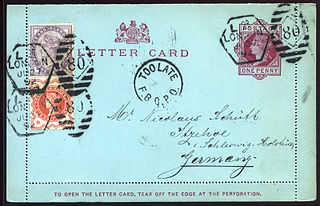
A piece of postal stationery is a stationery item, such as a stamped envelope, letter sheet, postal card, lettercard, aerogram or wrapper, with an imprinted stamp or inscription indicating that a specific rate of postage or related service has been prepaid. It does not, however, include any postcard without a pre-printed stamp.

In philately, a block is a group of four or more un-separated stamps. Blocks are of interest not only because they are rarer than individual stamps, but they also preserve relative positions of stamps as they were originally printed, information that is crucial to understanding how the stamps were produced.
A plate number coil (PNC) is a United States postage stamp with the number of the printing plate or plates printed on it. The plate number typically appears as one or more small digits in the margin at the bottom of the stamp. The plate number may be centered or, on some coil issues, located toward the right. Although most plate numbers are composed of just numbers, both a combination of letter and number may be used. In the case when a letter is represented in the plate number, an upper case letter usually appears at the beginning or at the end of the sequence with the former serving as a good identifier of the stamp printer.

A postage stamp booklet is a booklet made up of one or more small panes of postage stamps in a cardboard cover. Booklets are often made from sheets especially printed for this purpose, with a narrow selvage at one side of the booklet pane for binding. From the cutting, the panes are usually imperforate on the edges of the booklet. Smaller and easier to handle than a whole sheet of stamps, in many countries booklets have become a favored way to purchase stamps.
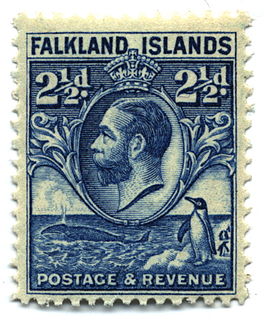
Topical or thematic stamp collecting is the collecting of postage stamps relating to a particular subject or concept. Topics can be almost anything, from stamps on stamps, birds, trains and poets on stamps, to famous physicians and scientists, along with historical people and events on stamps, which is often a standard theme for many stamp issuing countries.

The history of postage stamps and postal history of Malaysia, a state in Southeast Asia that occupies the south of the Malay peninsula and Sarawak and Sabah in the north Borneo, includes the development of postal services in these periods:
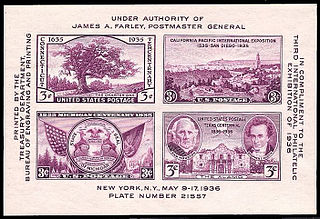
A souvenir sheet or miniature sheet is a small group of postage stamps still attached to the sheet on which they were printed. They may be either regular issues that just happen to be printed in small groups, or special issues often commemorating some event, such as a national anniversary, philatelic exhibition, or government program. The number of stamps ranges from one to about 25; larger sheets of stamps are simply called "sheets" with no qualifier.

The "Nixon invert" was a reputed invert error of the Richard Nixon memorial postage stamp issued by the United States in 1995. Originally reported in January 1996, it drew considerable attention that year; but in December a printing plant employee was arrested on charges of having stolen the misprinted stamps from the plant where he worked, meaning that instead of a legitimate error, they were worthless printer's waste.

The postage stamps of Ireland are issued by the postal operator of the independent Irish state. Ireland was part of the United Kingdom of Great Britain and Ireland when the world's first postage stamps were issued in 1840. These stamps, and all subsequent British issues, were used in Ireland until the new Irish Government assumed power in 1922. Beginning on 17 February 1922, existing British stamps were overprinted with Irish text to provide some definitives until separate Irish issues became available. Following the overprints, a regular series of definitive stamps was produced by the new Department of Posts and Telegraphs, using domestic designs. These definitives were issued on 6 December 1922; the first was a 2d stamp, depicting a map of Ireland. Since then new images, and additional values as needed, have produced of nine definitive series of different designs.
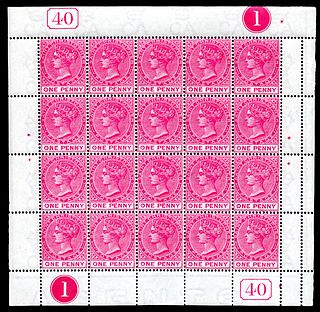
A sheet of stamps or press sheet is a unit of stamps as printed, usually on large sheets of paper based on the size of the printing plate, that are separated into panes that are sold at post offices. Where more than one pane is on a printed sheet they are arranged in a table-like arrangement. The spaces between the single stamps are all of the same size and provide space for a cut or perforation.
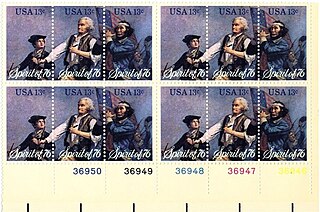
A triptych is a philatelic term which was borrowed from the art world and having the same meaning: a set of three panels hinged together. It is used to describe three se-tenant postage stamps of related design that make up a complete single design.

Plating refers to the reconstruction of a pane or "sheet" of postage stamps printed from a single plate by using individual stamps and overlapping strips and blocks of stamps. Likewise, if a sheet 10 or 20 postal cards is typeset, the variations of the letters or design elements may allow reconstruction or plating of the sheets based on these differences.

A plate number is a number printed in the margin of a sheet or roll of postage stamps, or on the stamp itself, which shows the printing plate used to print the stamps.
A plate number is the serial number of a printing plate. It is printed in the selvage or border of a pane of postage stamps.
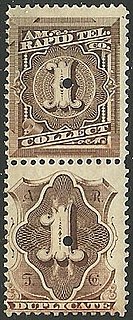
Se-tenant stamps or labels are printed from the same plate and sheet and adjoin one another, unsevered in a strip or block. They differ from each other by design, color, denomination or overprint. They may have a continuous design. The word "se-tenant" translates from French as meaning "joined together" or "holding together".
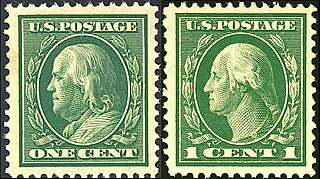
The Washington–Franklin Issues are a series of definitive U.S. Postage stamps depicting George Washington and Benjamin Franklin, issued by the U.S. Post Office between 1908 and 1922. The distinctive feature of this issue is that it employs only two engraved heads set in ovals—Washington and Franklin in full profile—and replicates one or another of these portraits on every stamp denomination in the series. This is a significant departure from previous definitive issues, which had featured pantheons of famous Americans, with each portrait-image confined to a single denomination. At the same time, this break with the recent past represented a return to origins. Washington and Franklin, after all, had appeared on the first two American stamps, issued in 1847, and during the next fifteen years, each of the eight stamp denominations available featured either Washington or Franklin.

The U.S. Parcel Post stamps of 1912–13 were the first such stamps issued by the U.S. Post Office Department and consisted of twelve denominations to pay the postage on parcels weighing 16 ounces and more, with each denomination printed in the same color of "carmine-rose". Their border design was similar while each denomination of stamp bore its own distinctive image in the center (vignette). Unlike regular postage items, whose rates were determined by weight in ounces, Parcel Post rates were determined and measured by increments in pounds. The new stamps were soon widely used by industry, farmers and others who lived in rural areas. Partly owing to some confusion involving their usage, their exclusive use as Parcel Post stamps proved short lived, as regular postage stamps were soon allowed to be used to pay parcel postage rates.